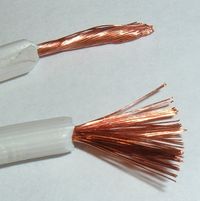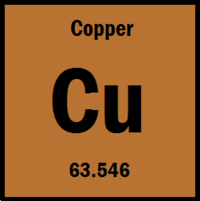Copper: Difference between revisions
J.williams (talk | contribs) m (1 revision imported) |
No edit summary |
||
| Line 1: | Line 1: | ||
[[Category:Done | [[Category:Done 2016-04-30]] | ||
[[File:COPPER.png|200px|thumb|Figure 1. Copper, [[atomic number]] of 29 and [[atomic weight]] of 63.546.<Ref>Made with information from the Royal Society of Chemistry, Available: http://www.rsc.org/periodic-table/element/29/copper</ref>]] | [[File:COPPER.png|200px|thumb|Figure 1. Copper, [[atomic number]] of 29 and [[atomic weight]] of 63.546.<Ref>Made with information from the Royal Society of Chemistry, Available: http://www.rsc.org/periodic-table/element/29/copper</ref>]] | ||
[[File:copperore.jpg|200px|thumb|Figure 2. Native copper (not combined to any other element and found naturally), approx. 4 cm in size.<ref>Wikimedia Commons [Online], Available: https://upload.wikimedia.org/wikipedia/commons/f/f0/NatCopper.jpg</ref>]] | [[File:copperore.jpg|200px|thumb|Figure 2. Native copper (not combined to any other element and found naturally), approx. 4 cm in size.<ref>Wikimedia Commons [Online], Available: https://upload.wikimedia.org/wikipedia/commons/f/f0/NatCopper.jpg</ref>]] | ||
<onlyinclude>'''Copper''' ('''Cu''') is the 29<sup>th</sup> [[element]] on the [[periodic table of elements|periodic table]], and is found fairly commonly on Earth, with approximately the same abundance as zinc and nickel.</onlyinclude><ref name=pt>PeriodicTable.com. (July 31, 2015). ''Abundance in Earth's Crust of the elements'' [Online], Available: http://periodictable.com/Properties/A/CrustAbundance.v.log.html</ref> Known for its distinct color (visible in Figure 2) copper was one of the first [[metal]]s ever manipulated by humans - with evidence suggesting its use for over 11 000 years.<ref name=jeff>Jefferson Lab. (July 31, 2015). ''The Element Copper'' [Online], Available: http://education.jlab.org/itselemental/ele029.html</ref> | <onlyinclude>'''Copper''' ('''Cu''') is the 29<sup>th</sup> [[element]] on the [[periodic table of elements|periodic table]], and is found fairly commonly on Earth, with approximately the same abundance as [[zinc]] and [[nickel]].</onlyinclude><ref name=pt>PeriodicTable.com. (July 31, 2015). ''Abundance in Earth's Crust of the elements'' [Online], Available: http://periodictable.com/Properties/A/CrustAbundance.v.log.html</ref> Known for its distinct color (visible in Figure 2) copper was one of the first [[metal]]s ever manipulated by humans - with evidence suggesting its use for over 11 000 years.<ref name=jeff>Jefferson Lab. (July 31, 2015). ''The Element Copper'' [Online], Available: http://education.jlab.org/itselemental/ele029.html</ref> | ||
Copper is used in large amounts in the [[electricity]] industry in the form of [[wire]], due to its high [[electrical conductivity]] (see the table below).<ref name=jeff/> Its conductivity is second only to [[silver]], however copper is about 860 times more abundant on Earth than silver,<ref name=pt/> so it is much cheaper. Although it is used predominantly in wiring, other uses for copper include plumbing, currency, and jewelry. Copper is too soft to be used alone in many materials, and people discovered long ago that it can be mixed with other metals to form strong alloys. Examples of this is copper's mixture with tin to make bronze, or with zinc to form brass.<ref name=jeff/> | Copper is used in large amounts in the [[electricity]] industry in the form of [[wire]], due to its high [[electrical conductivity]] (see the table below).<ref name=jeff/> Its conductivity is second only to [[silver]], however copper is about 860 times more abundant on Earth than silver,<ref name=pt/> so it is much cheaper. Although it is used predominantly in wiring, other uses for copper include plumbing, currency, and jewelry. Copper is too soft to be used alone in many materials, and people discovered long ago that it can be mixed with other metals to form strong alloys. Examples of this is copper's mixture with tin to make bronze, or with zinc to form brass.<ref name=jeff/> | ||
| Line 20: | Line 20: | ||
|- | |- | ||
| '''[[Electrical conductivity]]''' || 6.30×10<sup>7</sup> σ | | '''[[Electrical conductivity]]''' || 6.30×10<sup>7</sup> σ | ||
|- | |||
| '''[[Embodied energy]]'''<ref name=unep>UNEP. (August 19, 2015). ''Environmental Risks and Challenges of Anthropogenic Metals Flows and Cycles'' [Online]. Available: https://d396qusza40orc.cloudfront.net/metals/3_Environmental_Challenges_Metals-Full%20Report_36dpi_130923.pdf#96</ref> || 30-90 [[megajoule|MJ]]/[[kilogram|kg]] | |||
|} | |} | ||
| Line 36: | Line 38: | ||
===Construction=== | ===Construction=== | ||
Copper is the standard material for plumbing not only due to its high [[melting point]] and corrosion resistance, but also because it does not allow for the growth of bacteria or viruses. It is also | Copper is the standard material for plumbing not only due to its high [[melting point]] and corrosion resistance, but also because it does not allow for the growth of bacteria or viruses. It is also [[ductile]] and easy to solder; it is easy to bend and piece together. Examples of copper and its alloys in construction include [[heat exchanger]]s, [[pipeline]]s, [[agricultural water]] systems, handles, doorknobs and other building materials, and more.<ref name=abt/> | ||
==References== | ==References== | ||
{{Reflist}}[[Category:Uploaded]] | {{Reflist}}[[Category:Uploaded]] | ||
Revision as of 04:03, 24 May 2016

Copper (Cu) is the 29th element on the periodic table, and is found fairly commonly on Earth, with approximately the same abundance as zinc and nickel.[3] Known for its distinct color (visible in Figure 2) copper was one of the first metals ever manipulated by humans - with evidence suggesting its use for over 11 000 years.[4]
Copper is used in large amounts in the electricity industry in the form of wire, due to its high electrical conductivity (see the table below).[4] Its conductivity is second only to silver, however copper is about 860 times more abundant on Earth than silver,[3] so it is much cheaper. Although it is used predominantly in wiring, other uses for copper include plumbing, currency, and jewelry. Copper is too soft to be used alone in many materials, and people discovered long ago that it can be mixed with other metals to form strong alloys. Examples of this is copper's mixture with tin to make bronze, or with zinc to form brass.[4]
Some properties of copper include:[4][5]
| Atomic weight | 63.546 |
| Density (at 0oC) | 8.933 g/cm3 |
| Boiling point | 2835 K |
| Melting point | 1357.8 K |
| Electrical conductivity | 6.30×107 σ |
| Embodied energy[6] | 30-90 MJ/kg |
Uses of Copper
The uses of copper by percentage (estimated) are shown in the Figure below.[7]
Electrical

Copper is the major component of wiring. In a single vehicle there is about 1.5 kilometers of copper wiring, with a total mass of about 20 kilograms in small cars and 45 kilograms in luxury and hybrid cars.[9] Along with wiring of vehicles and other electronics, copper wiring is used in electrical generation and transmission (aside from overhead power lines, which are made from aluminum).
Aside from its excellent conductivity, copper is also very ductile so it is very easy to work with. Specific examples of copper use in electrical applications include circuit boards, microchips, semiconductors, electromagnets, electric motors, wind turbines, photovoltaic cells, and much, much more. Basically any wiring aside from power lines are formed with copper.[7]
Construction
Copper is the standard material for plumbing not only due to its high melting point and corrosion resistance, but also because it does not allow for the growth of bacteria or viruses. It is also ductile and easy to solder; it is easy to bend and piece together. Examples of copper and its alloys in construction include heat exchangers, pipelines, agricultural water systems, handles, doorknobs and other building materials, and more.[7]
References
- ↑ Made with information from the Royal Society of Chemistry, Available: http://www.rsc.org/periodic-table/element/29/copper
- ↑ Wikimedia Commons [Online], Available: https://upload.wikimedia.org/wikipedia/commons/f/f0/NatCopper.jpg
- ↑ 3.0 3.1 PeriodicTable.com. (July 31, 2015). Abundance in Earth's Crust of the elements [Online], Available: http://periodictable.com/Properties/A/CrustAbundance.v.log.html
- ↑ 4.0 4.1 4.2 4.3 Jefferson Lab. (July 31, 2015). The Element Copper [Online], Available: http://education.jlab.org/itselemental/ele029.html
- ↑ Chemistry on About.com. (July 31, 2015). Table of Electrical Resistivity and Conductivity [Online], Available: http://chemistry.about.com/od/moleculescompounds/a/Table-Of-Electrical-Resistivity-And-Conductivity.htm
- ↑ UNEP. (August 19, 2015). Environmental Risks and Challenges of Anthropogenic Metals Flows and Cycles [Online]. Available: https://d396qusza40orc.cloudfront.net/metals/3_Environmental_Challenges_Metals-Full%20Report_36dpi_130923.pdf#96
- ↑ 7.0 7.1 7.2 Metals @ About.com. (July 31, 2015). Copper Applications [Online], Available: http://metals.about.com/od/properties/a/Copper-Applications.htm
- ↑ Wikimedia Commons [Online], Available: https://upload.wikimedia.org/wikipedia/commons/7/74/Stranded_lamp_wire.jpg
- ↑ US Geological Survey. (July 31, 2015). Copper - A Metal for the Ages [Online], Available: http://pubs.usgs.gov/fs/2009/3031/FS2009-3031.pdf


